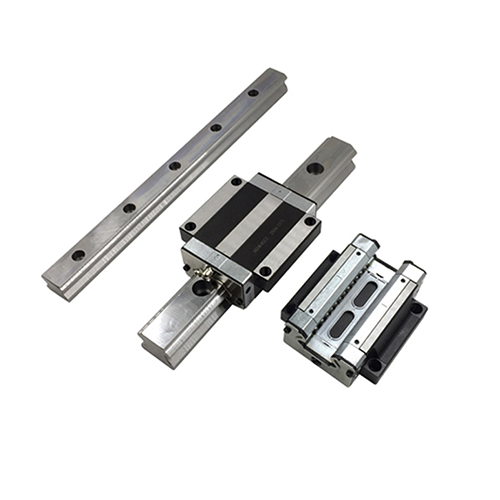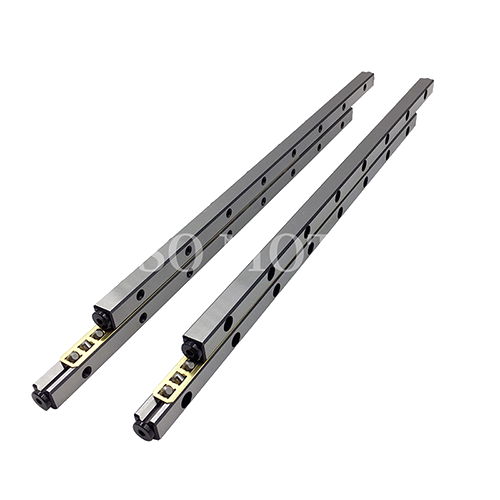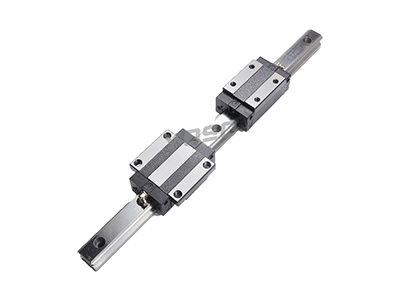In modern machinery and automation equipment, guide systems are key components for achieving precise linear motion. Linear guides and cross guides are two common guide types, differing significantly in their structure, load capacity, accuracy, and application scenarios. This article provides a detailed comparison of these two types to help you choose the most suitable guide system.
Linear Guide Rail
Structural Features:
Linear guides consist of a guide rail and a slider. The slider contains rolling elements (such as balls or rollers) that slide along the guide groove to achieve linear motion. Their relatively simple design makes them suitable for a wide range of standardized equipment.
Load Capacity and Accuracy:
Linear guides have a moderate load capacity and are generally used in applications with medium loads. While they offer higher accuracy, they perform less well than cross guides in applications with ultra-high precision requirements and heavy loads.

Applications:
CNC machine tools: Provide smooth linear motion.
Automation equipment: Excellent performance with light loads and medium accuracy requirements.
3D Printers: Precise linear motion.
Advantages:
Simple structure and easy installation.
Low cost, suitable for large-scale applications.
Provides sufficient accuracy and rigidity, suitable for equipment with medium loads and precision requirements.
Limitations:
Limited load capacity, unsuitable for heavy load applications.
Less suitable for applications requiring high precision and high rigidity.
Crossed Roller Guide
Structural Features:
Crossed Roller Guides use rollers arranged at 90-degree angles, creating two intersecting paths within the guide, capable of simultaneously supporting loads from multiple directions. This design provides greater stability and even load distribution.
Load Capacity and Precision:
Crossed guides have a much higher load capacity than linear guides, can withstand larger loads, and offer extremely high precision. Their accuracy often far exceeds that of linear guides, making them suitable for applications requiring high precision.

Applications:
Precision instruments: Such as optical equipment and measuring instruments.
High-end CNC machine tools: Suitable for ultra-high-precision machining.
Medical Equipment: Applications requiring extremely high precision and loads.
Advantages:
High load capacity, suitable for heavy-duty applications.
Provides extremely high precision and rigidity, suitable for precision equipment.
Can withstand loads from multiple directions simultaneously, suitable for complex mechanical environments.
Limitations:
Complex structure, making installation difficult.
Higher cost, suitable for specific applications requiring high precision and high loads.
Larger size compared to linear guides.
Summary of the comparison between linear guides and cross guides
| Feature | Linear Guide | Cross Roller Guide |
| Structure | Simple, slider and rail combination with ball/roller sliding | Crossed roller arrangement, load path crossed |
| Load Capacity | Medium, suitable for light to medium load applications | High, suitable for heavy load applications |
| Precision | High precision, but not suitable for extreme precision requirements | Extremely high precision, suitable for high-precision equipment |
| Application | CNC machines, automation equipment, 3D printers | Precision instruments, medical equipment, high-end CNC machines |
| Advantages | Simple structure, low cost, easy installation | High load, high precision, multi-directional load capacity |
| Limitations | Limited load capacity, not suitable for high precision and heavy load | High cost, complex structure, difficult installation |
How to Choose the Right Guide?
Linear guides are suitable for general automation equipment and applications with low to medium precision requirements, especially in cost-sensitive projects.
Cross guides are suitable for applications requiring high loads and ultra-high precision, especially in space-constrained equipment or equipment requiring extremely high precision, such as precision measuring instruments and medical equipment.
In short, the choice of guide depends on the equipment’s load requirements, accuracy requirements, and budget. By comparing the different characteristics of linear guides and cross guides, you can select the most suitable guide system for your equipment, thereby improving overall efficiency and performance.
 EN
EN
 AR
AR
 BG
BG
 CS
CS
 DA
DA
 NL
NL
 FI
FI
 FR
FR
 DE
DE
 EL
EL
 HI
HI
 IT
IT
 JA
JA
 KO
KO
 NO
NO
 PL
PL
 PT
PT
 RU
RU
 ES
ES
 SV
SV
 TL
TL
 ID
ID
 UK
UK
 VI
VI
 HU
HU
 TH
TH
 TR
TR
 FA
FA
 AF
AF
 MS
MS
 SW
SW
 GA
GA
 CY
CY
 BE
BE
 KA
KA
 LA
LA
 MY
MY
 TG
TG
 UZ
UZ


